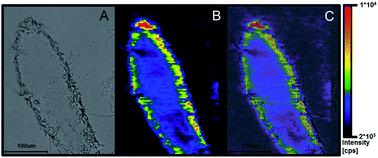当前位置:
X-MOL 学术
›
J. Anal. At. Spectrom.
›
论文详情
Our official English website, www.x-mol.net, welcomes your
feedback! (Note: you will need to create a separate account there.)
Elemental bioimaging of Na distribution in roots of Arabidopsis thaliana using laser ablation-ICP-MS under cold plasma conditions
Journal of Analytical Atomic Spectrometry ( IF 3.1 ) Pub Date : 2020-08-06 , DOI: 10.1039/d0ja00151a Sigrid Richter-Brockmann 1, 2, 3, 4 , Katia Garbert 2, 3, 4, 5 , Maximilian von Bremen-Kühne 1, 2, 3, 4 , Christoph A. Wehe 1, 2, 3, 4 , Olga Reifschneider 1, 2, 3, 4 , Michael Sperling 1, 2, 3, 4, 6 , Lukas Wallrad 2, 3, 4, 5 , Ina Schmitz-Thom 2, 3, 4, 5 , Jörg Kudla 2, 3, 4, 5, 7 , Uwe Karst 1, 2, 3, 4
Journal of Analytical Atomic Spectrometry ( IF 3.1 ) Pub Date : 2020-08-06 , DOI: 10.1039/d0ja00151a Sigrid Richter-Brockmann 1, 2, 3, 4 , Katia Garbert 2, 3, 4, 5 , Maximilian von Bremen-Kühne 1, 2, 3, 4 , Christoph A. Wehe 1, 2, 3, 4 , Olga Reifschneider 1, 2, 3, 4 , Michael Sperling 1, 2, 3, 4, 6 , Lukas Wallrad 2, 3, 4, 5 , Ina Schmitz-Thom 2, 3, 4, 5 , Jörg Kudla 2, 3, 4, 5, 7 , Uwe Karst 1, 2, 3, 4
Affiliation

|
Increasing soil salinity is a major problem in global crop production. The detrimental effect of saline soils on plant growth results from ionic toxicity of the Na+ ion in combination with osmotic perturbation. However, the mechanisms of Na uptake in roots, its transport to other tissues as well as the distribution of Na+ in specific plant tissues and cell layers are still not fully understood. The hyphenation of laser ablation (LA) and inductively coupled plasma mass spectrometry (ICP-MS) provides a well-suited tool for elemental bioimaging in plant tissues. Here, we present a novel LA-ICP-MS method which allows the generation of meaningful images of the Na distribution in Arabidopsis thaliana roots at the cellular level. For this purpose, a sample preparation protocol was developed which maintains the native Na distribution of the sample while avoiding contamination with Na+ from other sources. The ICP-MS was optimized to provide a high sensitivity for Na by applying cold plasma conditions. Plasma cooling was achieved by reducing the plasma power and delivering an additional wet aerosol to the ICP. By this means, the limit of detection was reduced by a factor of two in comparison with the standard mode. Images of the Na+ distribution in roots indicative of a distinctive accumulation of Na+ in defined A. thaliana root cell layers are thus obtained with a spatial resolution of down to 4 μm. Our analysis provides the first evidence for sharp Na concentration differences in roots, which are established between different cell layers and result in maximal Na accumulation in the cortex cells of the root organ.
中文翻译:

冷等离子体条件下激光烧蚀-ICP-MS对拟南芥根中Na分布的元素生物成像
增加土壤盐分是全球作物生产中的主要问题。盐渍土壤对植物生长的有害影响是由于Na +离子的离子毒性和渗透扰动共同作用的结果。但是,对根中Na吸收的机制,其向其他组织的运输以及Na +在特定植物组织和细胞层中的分布的机制仍未完全了解。激光烧蚀(LA)和电感耦合等离子体质谱(ICP-MS)的联用为植物组织中的元素生物成像提供了非常适合的工具。在这里,我们提出了一种新颖的LA-ICP-MS方法,该方法可以生成拟南芥中Na分布的有意义图像。根源于细胞水平。为此目的,开发了一种样品制备方案,该方案可保持样品的天然Na分布,同时避免被其他来源的Na +污染。ICP-MS经过优化,可通过冷等离子体条件对Na提供高灵敏度。通过降低等离子体功率并向ICP输送额外的湿气雾剂,可以实现等离子体冷却。通过这种方式,与标准模式相比,检测极限降低了两倍。根中Na +分布的图像表明在限定的拟南芥中Na +有独特的积累因此以低至4μm的空间分辨率获得了根细胞层。我们的分析为根中钠浓度的急剧差异提供了第一个证据,根浓度差异在不同的细胞层之间建立,并导致根器官的皮质细胞中最大的钠积累。
更新日期:2020-09-02
中文翻译:

冷等离子体条件下激光烧蚀-ICP-MS对拟南芥根中Na分布的元素生物成像
增加土壤盐分是全球作物生产中的主要问题。盐渍土壤对植物生长的有害影响是由于Na +离子的离子毒性和渗透扰动共同作用的结果。但是,对根中Na吸收的机制,其向其他组织的运输以及Na +在特定植物组织和细胞层中的分布的机制仍未完全了解。激光烧蚀(LA)和电感耦合等离子体质谱(ICP-MS)的联用为植物组织中的元素生物成像提供了非常适合的工具。在这里,我们提出了一种新颖的LA-ICP-MS方法,该方法可以生成拟南芥中Na分布的有意义图像。根源于细胞水平。为此目的,开发了一种样品制备方案,该方案可保持样品的天然Na分布,同时避免被其他来源的Na +污染。ICP-MS经过优化,可通过冷等离子体条件对Na提供高灵敏度。通过降低等离子体功率并向ICP输送额外的湿气雾剂,可以实现等离子体冷却。通过这种方式,与标准模式相比,检测极限降低了两倍。根中Na +分布的图像表明在限定的拟南芥中Na +有独特的积累因此以低至4μm的空间分辨率获得了根细胞层。我们的分析为根中钠浓度的急剧差异提供了第一个证据,根浓度差异在不同的细胞层之间建立,并导致根器官的皮质细胞中最大的钠积累。











































 京公网安备 11010802027423号
京公网安备 11010802027423号